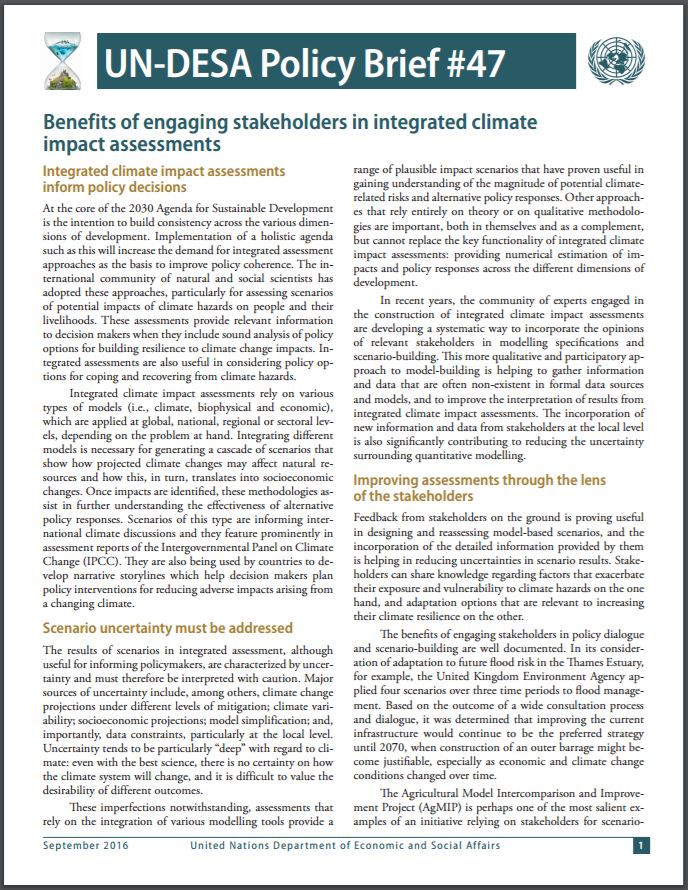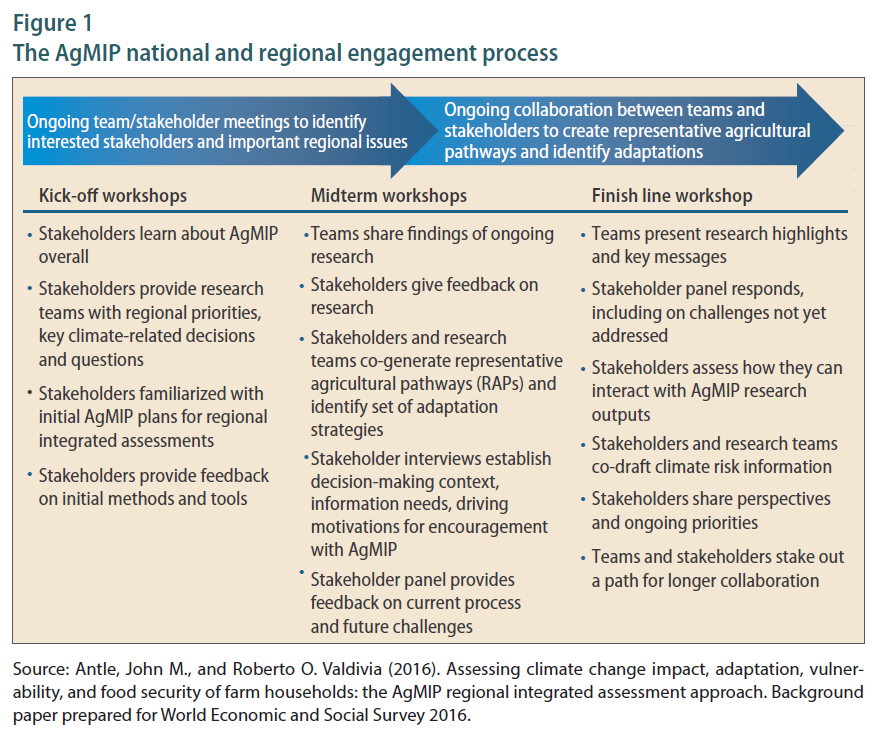
UN/DESA Policy Brief #47: Benefits of engaging stakeholders in integrated climate impact assessments
Integrated climate impact assessments inform policy decisions
At the core of the 2030 Agenda for Sustainable Development is the intention to build consistency across the various dimensions of development. Implementation of a holistic agenda such as this will increase the demand for integrated assessment approaches as the basis to improve policy coherence. The international community of natural and social scientists has adopted these approaches, particularly for assessing scenarios of potential impacts of climate hazards on people and their livelihoods. These assessments provide relevant information to decision makers when they include sound analysis of policy options for building resilience to climate change impacts. Integrated assessments are also useful in considering policy options for coping and recovering from climate hazards.
Integrated climate impact assessments rely on various types of models (i.e., climate, biophysical and economic), which are applied at global, national, regional or sectoral levels, depending on the problem at hand. Integrating different models is necessary for generating a cascade of scenarios that show how projected climate changes may affect natural resources and how this, in turn, translates into socioeconomic changes. Once impacts are identified, these methodologies assist in further understanding the effectiveness of alternative policy responses. Scenarios of this type are informing international climate discussions and they feature prominently in assessment reports of the Intergovernmental Panel on Climate Change (IPCC). They are also being used by countries to develop narrative storylines which help decision makers plan policy interventions for reducing adverse impacts arising from a changing climate.
Scenario uncertainty must be addressed
The results of scenarios in integrated assessment, although useful for informing policymakers, are characterized by uncertainty and must therefore be interpreted with caution. Major sources of uncertainty include, among others, climate change projections under different levels of mitigation; climate variability; socioeconomic projections; model simplification; and, importantly, data constraints, particularly at the local level. Uncertainty tends to be particularly "deep" with regard to climate: even with the best science, there is no certainty on how the climate system will change, and it is difficult to value the desirability of different outcomes.
These imperfections notwithstanding, assessments that rely on the integration of various modelling tools provide a range of plausible impact scenarios that have proven useful in gaining understanding of the magnitude of potential climate-related risks and alternative policy responses. Other approaches that rely entirely on theory or on qualitative methodologies are important, both in themselves and as a complement, but cannot replace the key functionality of integrated climate impact assessments: providing numerical estimation of impacts and policy responses across the different dimensions of development.
In recent years, the community of experts engaged in the construction of integrated climate impact assessments are developing a systematic way to incorporate the opinions of relevant stakeholders in modelling specifications and scenario-building. This more qualitative and participatory approach to model-building is helping to gather information and data that are often non-existent in formal data sources and models, and to improve the interpretation of results from integrated climate impact assessments. The incorporation of new information and data from stakeholders at the local level is also significantly contributing to reducing the uncertainty surrounding quantitative modelling.
Improving assessments through the lens of the stakeholders
Feedback from stakeholders on the ground is proving useful in designing and reassessing model-based scenarios, and the incorporation of the detailed information provided by them is helping in reducing uncertainties in scenario results. Stakeholders can share knowledge regarding factors that exacerbate their exposure and vulnerability to climate hazards on the one hand, and adaptation options that are relevant to increasing their climate resilience on the other.
The benefits of engaging stakeholders in policy dialogue and scenario-building are well documented. In its consideration of adaptation to future flood risk in the Thames Estuary, for example, the United Kingdom Environment Agency applied four scenarios over three time periods to flood management. Based on the outcome of a wide consultation process and dialogue, it was determined that improving the current infrastructure would continue to be the preferred strategy until 2070, when construction of an outer barrage might become justifiable, especially as economic and climate change conditions changed over time.
The Agricultural Model Intercomparison and Improvement Project (AgMIP) is perhaps one of the most salient examples of an initiative relying on stakeholders for scenario-building. AgMIP developed an integrated framework to study heterogeneous populations of farm households whose livelihoods depend on agricultural systems and are challenged by climate change. Representative agricultural pathways are one of the outstanding features of this framework: they are scenarios that provide information that models would usually not generate (i.e., they add details about the future socioeconomic conditions to which farm households may be exposed and also help project a level of detail on farm inputs).
In developing regional studies, AgMIP research teams have regular interactions with stakeholders over the life of the project (figure 1). Two groups of stakeholders participate: higher-level decision makers and experts, and communities of farmers. The interactions with these stakeholders are particularly important for scenario design, with a core objective being the generation of representative agricultural pathways (RAPs).
A comparison of AgMIP studies analysing improved socioeconomic conditions in the future under climate change in regions in Senegal and Zimbabwe attests to the importance of engaging stakeholders for reducing uncertainty in scenario results.1 In this comparison, only the Zimbabwe team relied on interactions with farmers and local experts to estimate key trends in developing the scenarios. Interestingly, the results for Senegal show a larger variability in the range of net economic impacts and also a much larger positive impact of improved socioeconomic conditions in the future. In the case of Zimbabwe, direct interaction with farmers improved the precision of estimates (i.e., it reduced the uncertainty in the results) and facilitated a more realistic assessment of the implications of improved socioeconomic conditions under climate change.
Engaging with stakeholders has other ancillary benefits
There can be ancillary benefits in engaging stakeholders beyond reducing scenario uncertainty and bringing more realism into the analysis of adaptation options. The feedback of vulnerable population groups and communities can be particularly important for achieving a deeper understanding of the factors that exacerbate people’s exposure and vulnerability to climate hazards, including how those factors may relate to the structural inequalities that require integrated and coherent policy responses.
For example, scenarios built in collaboration with stakeholders in the Nkayi region of Zimbabwe, as part of an AgMIP initiative, suggest that asset ownership is an important contributor to an understanding of the unequal effects of climate change and the effectiveness of adaptation strategies. Scenario results show that without adaptation measures, farmers possessing cattle are more exposed, inasmuch as the main adverse impact of climate change is not on crops but on livestock feed availability and livestock productivity. However, farms without cattle are poorer and more dependent on a single source of farm income, and are thus more vulnerable to climate change. Indeed, in the absence of adaptation, the study finds that the impact of climate change will be relatively greater on farms with no cattle. In this case, account was taken of the factors that determined differential levels of exposure and vulnerability across the spectrum of farmers. As a result, simulated scenarios were more adequately designed to analyse adaptation strategies and their capacity to (i) address the specific constraints of farmers and (ii) generate substantial impacts on per capita incomes, with a significant increase in the incomes of the poorest farmers.
More broadly, engagement of stakeholders in the discussion of policy options derived from integrated assessments is a critical practice in helping build consensus around development priorities, in strengthening policy coordination, and in the governance of decision-making processes.
The data and statistics challenge going forward
The regional studies developed by the AgMIP project, as those cited above, relied on their own farm surveys in different regions, because information on heterogeneous farm systems at the local level is not collected under standardized processes. More broadly, there are important data and statistics gaps to identify the most vulnerable population groups and communities whose feedback, as noted, is critical to improving integrated climate impact assessments. Information to help identify characteristics of vulnerable populations at the local level in developing regions, where adaptation is most needed, is lacking. Collaboration with the international statistical community will play a fundamental role in building and assessing existing and new data and statistical capacity for climate resilience.

Follow Us